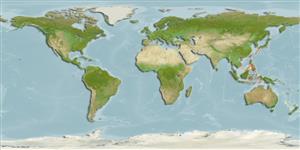Classification / Names
Common names | Synonyms | Catalog of Fishes(genus, species) | ITIS | CoL | WoRMS | Cloffa
Environment: milieu / climate zone / depth range / distribution range
Ecology
Marine; bathypelagic; depth range 622 - 1412 m (Ref. 36330). Deep-water
Western Central Pacific: Sulu Sea.
Size / Weight / Age
Maturity: Lm ? range ? - ? cm
Max length : 23.4 cm SL male/unsexed; (Ref. 36330)
Short description
Identification keys | Morphology | Morphometrics
Dorsal soft rays (total): 17 - 21; Anal soft rays: 14 - 18. Body shallow, maximum depth reaching 20%SL. Caudal peduncle relatively long (usually >18%SL). Vertical fin bases against each other. Head not very deep, moderately wide (postorbital width 11-12.5%SL). Snout very short but not blunt; its length 1.5-2.3 times smaller than orbit diameter; olfactory bulbs relatively large; ethymoid in olfactory bulb region relatively narrow. Eyes very large; orbit > 30% HL; no aggregations of light connective tissue in the orbit area around the eyeball; interorbital gap very narrow and < half the orbit diameter. Lacrimal not deep, significantly smaller than lens diameter, slightly overlapping maxillare. Seismosensory canals on head not extended, their pores not enlarged. No separate suprapreoperculum at the upper end of the praeoperculum; preopercular canal connects to the postorbital canal by means of a skin tube. Upper edge of upper jaw overlaps with the vertical of the rear edge of the lens, it may reach the vertical of the back edge of the orbit in large specimens. Supramaxilla 2; front one relatively long; its length equal or shorter than upper outgrowth of the posterior one. Photophores present on the head: a row of 4-5 infraorbitalias; 1 behind back edge of the orbit at its middle level; 5 on both sides along the lower jaw seismosensory canals; 2-4 along the upper 3 rays of the gill membrane; 1 each on the operculum, interoperculum, and between orbit and olfactory capsule. Photophores on body, situated above and below the lateral line, the size increases in the vertical direction that the largest ones cover the lower profile of the body; in front of the vertical fins; 3 rows in the caudal region; several irregular rows of small ones on the gill membranes. Pyloric caeca < 10 (Ref. 36330).
Life cycle and mating behavior
Maturity | Reproduction | Spawning | Eggs | Fecundity | Larvae
Sazonov, Y.I., 1999. A new species of the genus Rouleina (Argentiniformes, Alepocephalidae) from the Philippine Archipelago Seas and a redescription of R. livida and R. nuda. J. Ichthyol. 39(7):479-487. (Ref. 36330)
IUCN Red List Status (Ref. 130435: Version 2024-2)
Threat to humans
Harmless
Human uses
Tools
Special reports
Download XML
Internet sources
Estimates based on models
Preferred temperature (Ref.
123201): 5.4 - 10.1, mean 6.1 °C (based on 113 cells).
Phylogenetic diversity index (Ref.
82804): PD
50 = 0.5010 [Uniqueness, from 0.5 = low to 2.0 = high].
Bayesian length-weight: a=0.00347 (0.00163 - 0.00737), b=3.19 (3.00 - 3.38), in cm total length, based on LWR estimates for this (Sub)family-body shape (Ref.
93245).
Trophic level (Ref.
69278): 3.5 ±0.5 se; based on size and trophs of closest relatives
Resilience (Ref.
120179): Medium, minimum population doubling time 1.4 - 4.4 years (Preliminary K or Fecundity.).
Fishing Vulnerability (Ref.
59153): Low vulnerability (19 of 100).
